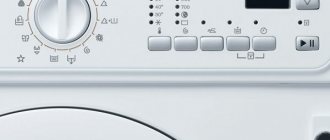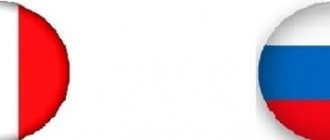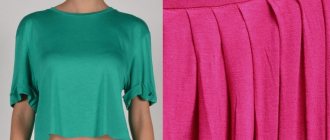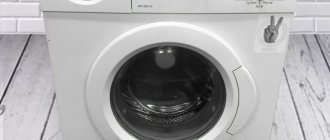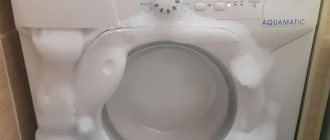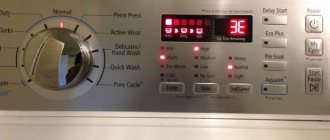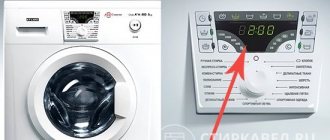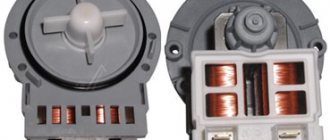Electrolux washing machines are popular and in demand in the domestic market, as they combine high quality with ergonomics and the ability to choose a device with the required characteristics.
For ease of use of the washing machine, you need to be aware of the manufacturer’s coding features.
We will look at the symbols on the Electrolux washing machine in the article.
Basic and additional icons: what do they look like and what do they mean?
Electrolux washing machines are high-tech modern household appliances with an attractive design. Some settings symbols are immediately clear to the user, others require decoding.
The main ones include the following:
- The symbol looks like a basin with an “I” icon inside, and indicates pre-wash; the same symbol is present on one of the powder receptacle compartments.
- The symbol depicting a basin with the “II” icon inside is the main wash.
- The spiral symbol is spin.
- Icon of a bowl of water with light jagged waves on the surface - rinsing.
- A basin filled with water – stop rinsing.
- A basin that has no bottom and an arrow drawn underneath it indicates draining water from the tank.
- The stylistic image of the door in the form of a vertical line and an arrow means the end of the cycle.
Additional icons on the case are also very informative.
Their number and type depend on the model and configuration, and therefore differ on devices. The most common include:
“TIMER NN”, where NN indicates the time in hours by which the start can be delayed;- “Very quiet” - for models with low noise levels;
- “N kg” - N – number of kilograms for maximum load;
- an icon depicting a bowl of water and an arc above it means additional rinsing;
- a square icon inside of which there is a circle and an arc with a double-headed arrow means imbalance control;
- schematic image of an iron in a square - easy ironing for straightening things in the drum;
- square with a picture of water and bubbles – foam control.
Washing programs can also be marked with icons:
- Schematic illustration of a cotton box - for washing cotton items.
- Test tube means washing synthetic fabrics.
- The sketchy flower is a delicate treatment.
- T-shirt pattern with stains - wash on intensive cycle.
- ECO – environmentally friendly washing.
- Butterfly – for washing silk.
- A skein of thread - for washing wool.
- 5 shirts – the mode is suitable for a small number of lightly soiled items, washing is carried out at a temperature of 30°C.
- Sneakers - for caring for sports shoes, synthetic clothing and refreshing things, the duration of the entire cycle is 30 minutes.
- Trousers - this symbol corresponds to the washing program for denim and dark fabrics at a temperature of no more than 60°C.
- The “blanket” icon indicates a washing program for bulky items with filling, varying the temperature within 30-60°C.
- Curtains – a program for washing curtains and drapes with water heated to 40°C and a cycle duration of 100 minutes, including pre-wash (which does not require detergent).
- Water basin and palm - hand wash.
It’s convenient when the washing machine body has both a symbolic image and a verbal description of the mode. This allows you to quickly navigate the selection of programs when starting a work cycle.
Video review of the Electrolux washing machine:
Designations for some brands of washing machines
Basically, in washing machines of different brands, the non-standard icons are those that indicate additional functions. Some brands seem to be specifically trying to highlight the introduction of innovation with new icons that are not on competitors’ products. There are also slight differences in the naming of traditional programs. Let's take a closer look at them.
Bosch
Many of the symbols used on the panel of Bosch washing machines, for example, Bosch MAXX 5, are standard (for example, the pre-wash, drain, spin, etc. icon), but there are also those that need to be discussed separately:
- a joint image of panties, a T-shirt and a T-shirt means the washing mode for cotton products (latest models often depict T-shirts and a box of cotton), if the same images are circled with a thick line, this means intensive washing;
- container with a wavy line – mode with an increased amount of water;
- image of an empty basin or dial with a highlighted period of time - quick wash;
- The iron icon corresponds to a mode that provides easy ironing of washed items;
- the image of a T-shirt (often with a hanger) is the washing mode for synthetics, the image of a nightgown is the delicate wash icon on Bosch washing machines, and the butterfly corresponds to washing silk items.
On modern Bosch units, all icons are signed, often there is no need to refer to the instructions
A decoding and description of the washing machine icons can always be found in the instructions for the equipment.
Samsung
On the control panels of washing machines from this company there are often no icons at all, and all the names of modes and functions are printed in Russian, which is very convenient for the user.
Samsung washing machine control panels contain minimal icons
Among the non-standard designations that can still occasionally be found on such units are the following:
- T-shirts with the bottom right edge shaded (or with circles in this place) indicate an intensive wash mode or the Eco Bubble function;
- the lock and/or smiling face corresponds to the child lock function;
- a basin with a wavy line at the top means soaking;
- crossed out speaker – the ability to turn off sound signals.
Indesit
Indesit manufacturers often place on the dashboard not only icons, but also the names of programs and options, so it’s not difficult to understand the meaning of the pictures. In addition, almost all designations are standard, there are very few exceptions:
- an image of a curtain, indicating the washing of tulle and curtain fabrics;
- dial pattern suitable for very fast washing.
Indesit washing units often use both icons and labels on control panels
The developers of LG brand washing machines also do not try to highlight their equipment by introducing non-standard images. On the dashboards, almost all programs are signed with words in Russian, and if there are icons, they are standard.
In the photo below you can see the dashboard of the LG F12U2HCS2 unit with standard on/off, pause and start icons.
On the control panels of many models of LG washing machines, icons are practically not used
Whirlpool
Among the symbols that can be found on Whirlpool brand washing machines are the following:
- the letter R placed in the basin means quick wash;
- the image of a shower corresponds to the rinse mode, and two showers drawn one after another indicate an additional rinse;
- the designation “½” located inside the basin implies a washing mode that saves water when rinsing;
- a large capital letter E means a mode that saves energy;
- the image of a feather symbolizes delicate washing;
- the spiral indicating spin can be of two types: tightly twisted and with large gaps between the turns. In the first case, this is a standard mode, in the second, a gentle mode.
The photo shows a fragment of the instructions for one of the Whirlpool washing machine models
Useful options
In addition to the main modes, the Electrolux washing machine provides a number of additional options:
- Direct Spray - spraying laundry with water to prevent wrinkles;
- Child protection – allows you to block the control panel from children and accidental settings;
- Steam System - steam treatment, which allows you to refresh things and prevent them from becoming wrinkled during processing;
- Time manager is an option that makes it possible to lengthen or shorten the duration of the processing cycle, but this setting can only be used in a limited number of modes;
- Aqua Control – notification when there is a water leak.
Icons on the washing machine: explanation
Immediately after purchasing a new washing machine, the question arises - how to operate it correctly. Each model has its own subtleties in the designation of washing modes and various functions. For some units, all levers and buttons are labeled in Russian, for others - in English, and for others, on the panel you can find icons in combination with inscriptions or even just pictures.
Quite often, washing modes and other additional functions are indicated on the control panel of the washing machine using icons
How to understand the icons on the washing machine? The obvious answer to this question is that you need to read the instructions. What if the document is lost or you received the machine without instructions? In our article we will talk about the symbols on washing machines: common to many brands and used by individual manufacturing companies.
Electrolux washing machine model marking coding
Each Electrolux washing machine model has its own coding. The set of letters and numbers encrypts the basic information about the technology, and it is not at all difficult to understand it.
The encoding of the current models that are currently on sale is as follows:
- In all TM Electrolux washing machines, the letter “E” is written first. This is the first letter of the word "Electrolux".
- The second symbol is always the letter “W”, which indicates that this is a washing machine.
- The third character is a number that indicates the series of the washing machine. For example, it would be “6” for the PerfectCare 600 series and “7” for the PerfectCare 700 series.
- Another letter in the encoding allows you to determine the type of washing machine:
- G – built-in;
- S – frontal, with a narrow body (up to 46 cm);
- W – washer-dryer;
- T – top loading;
- F – front loading;
- N – drying equipment with a heat pump;
- C – condensation type dryer.
- Two characters define the control type. For example, "4R", "3R".
- Maximum spin speed (coding corresponds to drum revolutions per minute):
- 0 — 1 000;
- 2 – 1 200;
- 4 – 1 400;
- 6 – 1 600.
- Maximum load of laundry into the drum (in kilograms).
- The color of the washing machine (from the name in English, by the first letter). For example, W is white.
- Type of motor in the washing machine.
The type of marking of Electrolux washing machines was changed in 2017. In older models the encoding was different.
Electrolux company
The company's assembly plants are located in several countries around the world, including:
Despite the wide geographical location of the company’s production sites, all products of this brand, without exception, are manufactured in compliance with all standards and quality requirements for equipment of this kind, which is confirmed by numerous positive reviews from users of various purposes and types of equipment of the above-mentioned brand. One of the core areas of the Electrolux concern is the production of high-tech automatic washing machines, individual models of which we will discuss in our article.
Error codes
The washing machine generates information about operating errors and failures automatically . The corresponding code is shown on the display. This allows you to quickly respond to a stop in work and easily find a unit that has stopped working normally.
The error code, depending on the specific model, may look like “ERROR”, “ERR” or “E”. Following the letter designation is a code that indicates what kind of trouble has occurred with the automatic washing machine, and which unit should be paid attention to during diagnostic measures.
Electrolux errors that may be seen on the display:
- E10 / E11 - no water supply, the waiting time for water supply has been exceeded (the reason may be not only a blockage, but also a failure of elements on the control board);
- E13 – leak;
- E20 / E21 / EF0 / EF1 – drain error (blockages, malfunctions, failures);
- E23 / E24 – drainage violation, faulty triacidac;
- E31 – E34 – pressure switch malfunction;
- E50 – E55 – motor malfunction;
- E52, E56, E59 – malfunctions of the tachogenerator installed on the motor;
- E57, E58 – high voltage in the network;
- E61, E62, E66, E68, E69, E3A, E71, E74 – errors related to water heating (including heating element failures, malfunctions, sensor failure, etc.);
- E40 – E45 – errors associated with the hatch door;
- E90 – E91 – problems with the control module;
- EF5 – imbalance;
- EH3 – network voltage is too low;
- EH1 – voltage is not normal;
- EH2 – network voltage is too high;
- EF2 – increased foam formation.
In some cases, error codes may alternate on the display if multiple nodes are involved in the failure. Some problems can be fixed even on your own, while others may require serious diagnostics and professional repairs.
Error codes for the Electrolux washing machine are discussed in the video:
Wash
A group of symbols with the manufacturer’s recommendations for washing the fabric from which the item is made. Covers both washing methods and temperatures. Using a machine to freshen up your wardrobe items can damage some of them. Rotating the drum too vigorously can deform the material or cause the product to shrink so that you can no longer wear your beautiful wool sweater. Developers of automatic machines take into account such risks and program their equipment for different washing modes: with intense and slow rotation of the drum, with strong and weak water heating, with copious rinsing and minimal spinning.
Washing methods
| A product with such a symbol on the label can be soaked, machine washed with pre-soaking, and can also be mechanically affected in every possible way: rubbed, wrung out and twisted. The material can even withstand boiling, while its fibers will retain their original state and the color will not be lost. |
| This symbol means "gentle wash". Wardrobe items should be washed carefully and the spin speed should be medium. |
| Such a symbol requires you to wash the product delicately. If you clean it by hand, you should use plenty of water as the concentrated powder can damage the fibers of the fabric. For the same reason, you cannot rinse a thing with such a symbol for a long time, rub it or squeeze it hard. When washing in an automatic machine, you just need to select the “delicate cycle”. |
| This symbol indicates that washing such a wardrobe item is prohibited (No wash or Do not wash). You can only freshen an item by dry cleaning, since even gentle hand washing will cause the fabric to shrink and the item to lose its shape. |
| Machine washing is strictly prohibited. When the fabric is rotated in a drum, it can stretch, become damaged and lose color. Such designations are often found on the tags of outfits heavily decorated with rhinestones, sequins and other decorative elements, which can come off when washed in a machine. |
| This icon indicates that the item can only be washed by hand at a comfortable temperature of no higher than 40 degrees. Outfits with this symbol on the label should not be rubbed, squeezed or twisted too much. Hand washing is generally recommended for items made from delicate fabrics such as satin, chiffon, guipure and knitwear. |
Signs indicating the required temperature conditions
Since many fabrics may lose shape, color, or shrink greatly when exposed to excessive temperatures, it is necessary to follow the manufacturers' recommendations. Washing water that is too hot can ruin your wardrobe items and you will no longer be able to wear them.
Such signs indicate which temperature mode is best to use when washing, so as not to damage the fabric fibers, deform the product, or wash out the color from it. The lower the number, the more delicate handling the material requires.
The next group of icons slightly duplicates the previous ones, indicating the recommended water temperature. They also talk about the method of washing, spinning and acceptable detergents. Such designations are accepted in the USA, and their decoding is not difficult: the temperature of the water for treatment increases along with the number of points.
| This symbol on the tag indicates that the fabric should be washed carefully, at a temperature of 30 degrees, without rubbing or wringing. If you plan to use a washing machine, you need to set the spin intensity to minimum. |
Wash at 40, 50, 60, 75 and 95 degrees respectively.
Video
We offer you to watch a video on the topic of the article.
She graduated from the author's physics and mathematics lyceum and art school. Received a higher education in economics with a major in innovative management. Freelancer. Married, actively travels. He is interested in Buddhist philosophy, enjoys transurfing and loves Mediterranean cuisine.
Found a mistake? Select the text with the mouse and click:
Stretch ceilings made of PVC film can withstand from 70 to 120 liters of water per 1 m2 of their area (depending on the size of the ceiling, the degree of its tension and the quality of the film). So you don’t have to worry about leaks from neighbors above.
Fresh lemon is not only suitable for tea: clean dirt from the surface of an acrylic bath by rubbing with half a cut citrus, or quickly wash the microwave by placing a container of water and lemon slices in it for 8-10 minutes at maximum power. The softened dirt can simply be wiped off with a sponge.
The dishwasher cleans more than just plates and cups. You can load it with plastic toys, glass lamp shades and even dirty vegetables, such as potatoes, but only without using detergents.
The habit of using an automatic washing machine “sparingly” can lead to the appearance of an unpleasant odor in it. Washing at temperatures below 60℃ and short rinses allow fungi and bacteria from dirty clothes to remain on internal surfaces and actively multiply.
The easiest way to remove scale and carbon deposits from the soleplate of the iron is with table salt. Pour a thick layer of salt onto the paper, heat the iron to maximum and run the iron over the salt bed several times, applying light pressure.
Threads made of gold and silver, which were used to embroider clothes in the old days, are called gimp. To obtain them, the metal wire was pulled for a long time with pliers to the required fineness. This is where the expression “to drag out the rigmarole” came from - “to do long, monotonous work” or “to delay the completion of a task.”
Before removing various stains from clothing, you need to find out how safe the selected solvent is for the fabric itself. It is applied in a small amount to an inconspicuous area of the item from the inside out for 5-10 minutes. If the material retains its structure and color, you can move on to stains.
There are special traps to combat moths. The sticky layer with which they are covered contains female pheromones that attract males. By sticking to the trap, they are eliminated from the reproduction process, which leads to a decrease in the moth population.
If your favorite things show the first signs of gestation in the form of untidy pellets, you can get rid of them using a special machine - a shaver. It quickly and effectively shaves off clumps of fabric fibers and returns things to their proper appearance.

